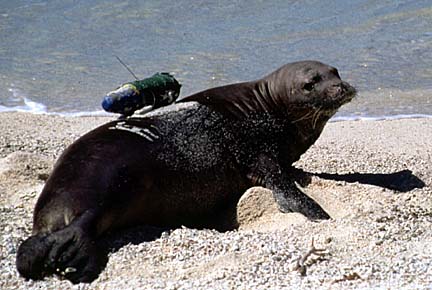
COURTESY OF NATIONAL GEOGRAPHIC
A monk seal wears a back-mounted camera that was used to take footage for tomorrow's National Geographic show.
Isle monk seals
film their own
TV specialThe marine mammals don cameras
to reveal unique home movies
Fitted with underwater cameras, Hawaiian monk seals are teaching Hawaii researchers more about their lives than ever before.
Monk seals special airs tomorrow
A National Geographic special featuring Hawaiian monk seals wearing Crittercam underwater cameras will air at 3 and 7 p.m. tomorrow on the National Geographic Channel.
From a seal's-eye view, the animals are showing what and how they eat, and how they play and fight with each other in their underwater world.
A National Geographic television special airing tomorrow features the charming but endangered marine mammals, which live exclusively in Hawaii, mostly in the uninhabited Northwestern Hawaiian Islands.
Scenes in the 30-minute special were compiled during eight years in the French Frigate Shoals, using 40 different seals who carried the small, back-mounted cameras for several days each. They show:
>> The seals dining on eels, fish and octopuses, many of which they roust out of hiding by using their noses to turn over large loose rocks on the sea floor."This is the only opportunity the seals have to show us what's important," said principal investigator Frank Parrish.
>> Younger seals traveling in groups -- apparently as protection from predatory sharks and aggressive older male monk seals that sometimes attack the youngsters.
>> Seals tangled in discarded ropes and other marine debris.The project is a cooperative venture between National Geographic and the National Oceanic and Atmospheric Administration's Pacific Islands Fisheries Science Center in Honolulu.
National Geographic owns and operates the cameras, which it has fitted to a number of different wild marine and land animals for its ongoing Crittercam TV series.
NOAA scientists pore over the information revealed by the underwater footage. The project, which is continuing, is funded in part by a grant from the National Science Foundation.
Researcher Bud Antonelis said scientists hope the Crittercam research will show them why juvenile seals on the French Frigate Shoals, in the Northwest Hawaiian Islands, are dying at an alarming rate.
In the 1980s eight of 10 young monk seals on French Frigate Shoals lived to see their second birthday. Now the two-year survival rate has dropped to two out of 10, said Antonelis, chief of the science center's protected-species division.
With a total estimated population of 1,300 seals in all the Hawaiian Islands, that rate of juvenile deaths threatens the survival of the species, Antonelis said.
Information from the Crittercam might help scientists find ways to improve the survival rate, he said.
One of the first revelations from the Crittercam footage was that monk seals do not feed on fish in shallow coral reefs. They go to deeper, sandy-bottom areas, where they compete with sharks and ulua (jacks) for the available smaller fish.
That was a wake-up call for researchers, who had been studying the reef fish under the mistaken assumption they were the monk seals' food source. Now the scientists can refocus their fish studies in deeper, sandy areas that the Crittercam seals showed them.
